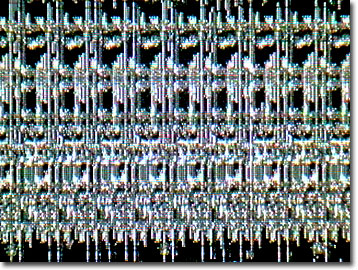Integrated Circuit Image Gallery
Intel Eraseable Programmable Read-Only Memory (EPROM)
Erasable programmable read-only memory (commonly referred to by the acronym EPROM) offers developers and users of microprocessor-controlled devices options for customizing their equipment, turning somewhat away from the off-the-shelf, one-size-fits-all ideal. Without the great expense of custom design and production, these chips also enable manufacturers to upgrade or debug electronic devices before shipping, without having to redesign and retool their assembly lines.

View a second image of an EPROM chip.
Known also as "electrically" or "erasable" PROMs, depending on the source of information, EPROMS retain the programming content in memory, until exposed to ultraviolet light or the proper sequence of electrical pulses. Once the contents of the memory are cleared, it is possible to reprogram the read-only memory chip. Whether the computer manufacturer or a third-party developer "burned" instructions as "firmware" onto an EPROM or the user "flashes" custom programs, the modified chip is set to carry out its specialized instructions.
Different types of EPROMs include electronically alterable programmable read-only memory (EAPROM), electrically erasable programmable read-only memory (EEPROM), and smart flash read-only memory (SFROM), which allows continuous read, write, and rewrite functions in the absence of ultraviolet erase. SFROM is ideal for non-volatile memory devices since it is reprogrammable and provides relatively large flash storage capacity. PROMs differ from EPROMs in that once they have had their instructions coded into the memory circuits, they cannot be erased. Unlike random access memory (RAM), EPROMs and PROMs retain their information content when the computer or other device is turned off. When first marketed in the mid-1980s, Intel EPROM chips ranged from 64 to 256 kilobytes.
Contributing Authors
Omar Alvarado, Thomas J. Fellers and Michael W. Davidson - National High Magnetic Field Laboratory, 1800 East Paul Dirac Dr., The Florida State University, Tallahassee, Florida, 32310.
BACK TO THE INTEGRATED CIRCUIT IMAGE GALLERY
BACK TO THE DIGITAL IMAGE GALLERIES
Questions or comments? Send us an email.
© 1995-2025 by Michael W. Davidson and The Florida State University. All Rights Reserved. No images, graphics, software, scripts, or applets may be reproduced or used in any manner without permission from the copyright holders. Use of this website means you agree to all of the Legal Terms and Conditions set forth by the owners.
This website is maintained by our
Graphics & Web Programming Team
in collaboration with Optical Microscopy at the
National High Magnetic Field Laboratory.
Last Modification Friday, Nov 13, 2015 at 01:19 PM
Access Count Since September 17, 2002: 13190
Visit the website of our partner in introductory microscopy education:
|
|
